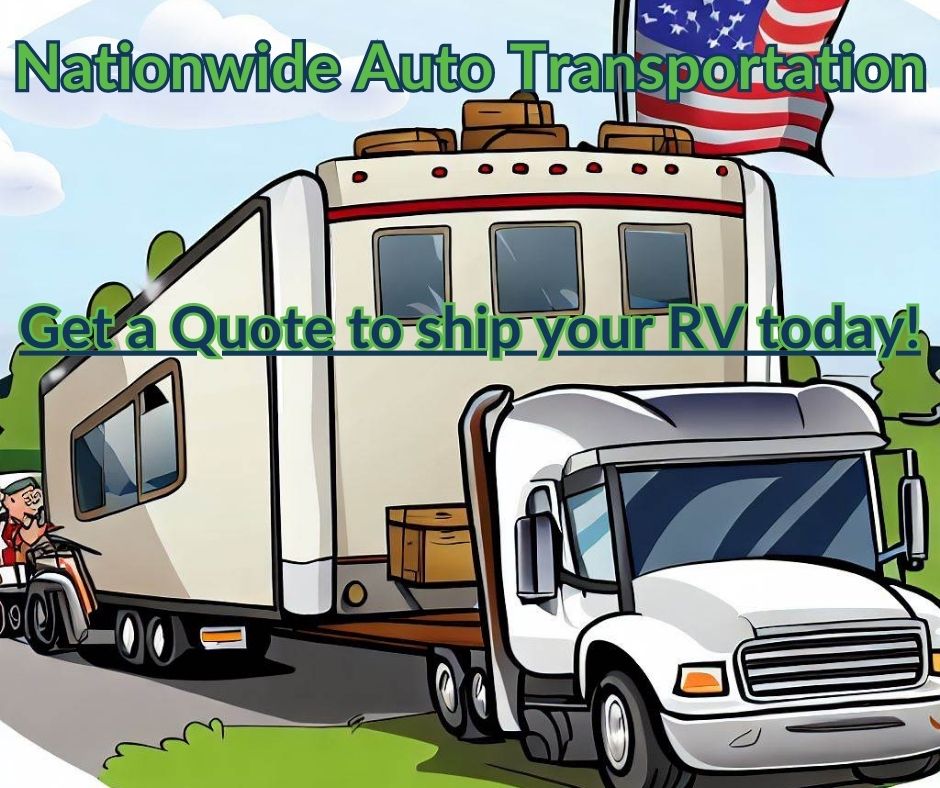
Reading Time: 12 minutes
The Dos and Don’ts of Shipping Your RV
What do you know about shipping recreational vehicles? Are you planning on moving to a new location? When your RV needs repairs, or you are selling it, it’s important to understand the dos and don’ts of shipping your valuable investment.
In this article, we’ll walk you through the key steps to consider when shipping your RV.
- Common mistakes to avoid
- Additional tips for a smooth process
- and insights into the cost and timing of RV shipping.
By the end, you’ll have the knowledge and confidence to navigate the shipping process like a pro.
Shipping an RV can be a complex task. However, with careful planning and the right approach, you can enjoy a hassle-free experience. Let’s get started with the key steps you should consider before shipping your RV.

🚗 “Planning your winter getaway and worried about your vehicle? Check out our essential guide on Snowbird Auto Transport for hassle-free car relocation this snowbird season. Discover tips, tricks, and expert advice for a smooth journey!”
Key Steps to Consider When Shipping Your RV
Shipping your RV can be an exciting and convenient way to transport your home away from home to a new location. Whether you’re moving, need repairs, or want to store your RV, it’s important to follow key steps to ensure a smooth and safe shipping process. Here are some essential dos and don’ts to keep in mind:
Shipping recreational vehicles? Getting Multiple Quotes
- Do: Get multiple quotes from reputable shipping companies. This will help you compare prices and services to find the best option for your needs.
- Don’t: Choose the first company you come across without exploring other options. Taking the time to research and gather quotes will ensure you make an informed decision.
Choosing a Licensed and Insured Company
- Do: Choose a shipping company that is licensed and insured. This will give you peace of mind knowing that your RV is in capable hands and that you’re protected in case of any damages or accidents.
- Don’t: Risk working with unlicensed or uninsured companies. This can lead to potential legal issues and financial losses if something goes wrong during the shipping process.
Having Everything in Writing When Shipping Recreational Vehicles
- Do: Have everything in writing, including the price, terms of service, and insurance details. This serves as a written agreement between you and the shipping company and ensures transparency and clarity throughout the process.
- Don’t: Rely solely on verbal agreements or handshake deals. Having everything documented protects both parties involved and provides a reference point in case of any misunderstandings or disputes.
Inspecting and Securing Your RV
- Do: Thoroughly inspect your RV before shipping. Check for any existing damages and take photos as evidence.
- Don’t: Neglect this step, as it can be crucial for insurance claims if any damages occur during transport. Make sure to secure all loose items inside the RV to prevent them from shifting during transit.
Emptying Tanks and Disconnecting Utilities
- Do: Empty all water, sewage, and propane tanks before shipping. Disconnect any utilities to prevent accidents or damage.
- Don’t: Forget to perform these essential tasks. Failing to do so can lead to leaks, odors, and potential hazards during shipping.
Marking Your RV with Contact Information
- Do: Clearly mark your RV with your contact information, including your name, phone number, and email address. This will make it easier for the shipping company to reach you if needed.
- Don’t: Overlook this step. In case of any delays or inquiries, having your contact information readily available on your RV will facilitate communication.
Remember, these key steps are crucial to shipping recreational vehicles safely. By following these dos and don’ts, you’ll be well-prepared and confident in your decision to ship your beloved home on wheels.
“Consider these key steps to ensure a smooth and safe shipping process for your RV. Taking the time to research, gather quotes, choose a licensed and insured company, and have everything in writing will provide peace of mind throughout the shipping journey.”
RV Shipping: Need specifics on RV shipping services? Dive into our comprehensive RV shipping guide and make your transition smooth.
Choosing the Right Boat Trailer for Shipping | What to Consider? is a must read for boat owners!
Common Mistakes to Avoid When Shipping Recreational Vehicles
Tips for RV transportation! When it comes to shipping your RV, there are certain mistakes that you should avoid to ensure a smooth and hassle-free experience. By being aware of these common pitfalls, you can save yourself from unnecessary stress and potential damage to your beloved recreational vehicle. Here are some mistakes to steer clear of when shipping your RV:
- Choosing the cheapest option.
- It is always tempting to go for the lowest-priced shipping service. Yet, it’s important to remember that quality often comes at a price. Opting for a cheap shipping option may mean sacrificing essential features. What about insurance coverage, experienced drivers, or reliable customer service? Always prioritize quality and choose a reputable shipping company that meets your specific needs.
Are you caught off-guard by the winter chill and need to transport your vehicle to warmer climates? Discover our reliable and swift Last-Minute Snowbird Car Shipping solutions to ensure your car joins you in your sunny retreat without the hassle.
- Shipping in winter without insurance.
If you’re planning to ship your RV during the winter months, check that you have proper insurance coverage in place.
Winter weather conditions can be harsh, and accidents or damage can occur more frequently during this time. With insurance, you can protect yourself financially in case of any unexpected incidents.

- Leaving loose items.
- Before handing your RV over to the shipping company, make sure to remove any loose items inside or outside the vehicle. Loose items can become projectiles during transit and cause damage to the interior or exterior of your RV. Take the time to secure everything properly. Include any loose equipment, decorations, or personal belongings.
- Disconnecting the battery.
- Many RV owners make the mistake of disconnecting the battery before shipping their vehicles. While it may seem like a good idea to prevent battery drain, it’s not. Note that certain electrical systems in your RV, such as alarm systems or tracking devices, may rely on the battery for power. By disconnecting the battery, you could potentially disable these important features and compromise the safety and security of your RV.
Steer Clear of These Errors
- Avoid these common mistakes to guarantee a smooth and worry-free shipping experience for your RV.
- Take the time to research and choose a reliable shipping company.
- Properly prepare your RV for transit.
- Understand the importance of insurance coverage.
These are all key factors in the safe and secure shipment of your recreational vehicle. Steer clear of these errors to have a successful RV shipping experience.
Boat Shipping: Not just RVs! We’re also experts in boat shipping. Discover our top-notch services and ensure your boat’s safe transport.
Additional Tips for RV Transportation

When it comes to shipping your RV, there are a few additional tips that can help make the process smoother and more efficient. Whether you’re shipping your RV locally or long-distance, these tips will ensure that your RV arrives safely at its destination.
Here are some additional tips to keep in mind:
- Using a Flatbed Trailer for Long-distance Shipping: If you’re shipping your RV over a long distance, using a flatbed trailer is often a better option than towing it yourself. Flatbed trailers offer more stability and are designed to transport larger vehicles like RVs. They are equipped with sturdy tie-downs and ramps, making it easier to load and secure your RV for transport.
- Following Shipping Instructions Carefully If Shipping Yourself: If you’ve decided to ship your RV yourself, it’s crucial to carefully follow the shipping instructions provided by the company or the rental service. Make sure you understand how to properly secure your RV to the trailer or truck, as improper loading can lead to damage during transit. Additionally, familiarize yourself with any special requirements or restrictions for the route you’ll be taking.

- Planning Accommodations During Shipping: If your RV is being shipped over a long distance and you won’t be traveling with it, it’s essential to plan for accommodations along the way.
- Research RV parks or campgrounds in the areas where your RV will be unloaded and consider making reservations in advance, especially during peak travel seasons. This will ensure that you have a place to stay while waiting for your RV to arrive.
- RV Travel: A comprehensive source for all your RV-related queries! Includes travel tips and campsite recommendations. Perfect for RV enthusiasts!
Maximizing RV Lifespan: Shipping is just one part; consistent maintenance is key. Discover how to extend the lifespan of your RV.
Nationwide Auto Transportation
RV Shipping Tips for Everyone
Remember, these Tips for RV transportation are meant to complement the key steps of shipping your RV. Be sure to review the previous sections on getting multiple quotes, choosing a licensed and insured company, having everything in writing, inspecting and securing your RV, emptying tanks and disconnecting utilities, and marking your RV with contact information. By following these tips and steps, you’ll have peace of mind knowing that your RV is in safe hands and will reach its destination without any issues.
Now that you’re equipped with all the dos and don’ts of shipping your RV, you can confidently plan your RV shipment. Whether you’re moving to a new location, getting repairs done, putting your RV in storage, or selling it, shipping your RV can be a convenient and reliable option. Just remember to take the necessary precautions, choose a reputable shipping company, and properly prepare your RV for transport.
The Dyrt: Find the best campgrounds & RV parks across the USA. A must-visit for those seeking the best spots for their RV adventures!
Happy travels and safe shipping!
Do you need your RV or boat somewhere in a hurry? Expedited Car Shipping Costs | Your Quick Car Moves Guide is a must read for you!
Understanding the Cost and Timing of RV Shipping
When it comes to shipping recreational vehicles, it’s important to have a clear understanding of the cost and timing involved. This will help you plan and budget for your shipment effectively. Let’s take a closer look at the factors that influence the cost and timing of RV shipping.
Cost of RV Shipping
The cost of shipping an RV can vary depending on several factors.
- The size and weight of your RV,
- the distance it needs to be transported,
- and the shipping company you choose.
On average, the cost of shipping an RV can range from $1,000 to $3,000. However, it’s important to keep in mind that these are just estimates, and the actual cost may vary.

Go RVing: Discover the world of RVing! Explore various RV models, find events, and connect with a community that shares your passion.
🚍 Factors Affecting RV Shipping Costs 🚍
🛣️ Distance: The longer the journey, the higher the cost. Every mile counts due to fuel and resources!
📏 Size & Weight: Got a big RV? It might come with a bigger price tag. Remember, dimensions and weight matter!
🌞 Season: Ah, the sunny summer days! But remember, they’re also the priciest for RV shipping. Maybe try off-peak?
❄️ RV Winter Tips: Frosty forecasts? Make sure your RV is winter-ready. Dive into our chilly tips!
🎁 Additional Services: Extra goodies like door-to-door delivery or faster shipping? They might add a bit to the final bill.
Timing of Shipping Recreational Vehicles
Timing is another important aspect to consider when shipping your RV. It’s crucial to plan ahead and allow sufficient time for your shipment to ensure a smooth and timely process. Here are a few factors to keep in mind:
- Booking in Advance: It’s recommended to book your RV shipment well in advance, especially during peak seasons. Shipping companies may have limited availability, so booking early can help secure your preferred dates and avoid any last-minute delays.
- Delivery Time: The overall shipping time will depend on the distance and route of your shipment. Typically, long-distance shipments can take anywhere from a few days to a few weeks. It’s essential to discuss the estimated delivery time with your chosen shipping company to have a clear understanding of when you can expect your RV to arrive.
- Flexibility: Being flexible with your schedule can also help expedite the shipping process. If you have a specific timeframe in which you need your RV to be delivered, communicate this clearly with the shipping company. They may be able to accommodate your request or provide alternative solutions.
It’s always a good idea to communicate with the shipping company. Ask for a detailed timeline of the shipping process. This will help you plan your schedule and make any necessary arrangements at your destination.
In conclusion, understanding the cost and timing of RV shipping is crucial for a successful and stress-free experience. By considering the factors that influence the cost and timing, you can budget effectively, plan ahead, and ensure a smooth shipping process for your beloved RV.
Understanding the Purpose and Volume of RV Shipping
RV shipping has become a common practice in recent years, with a significant volume of recreational vehicles being transported across the country. Understanding the purpose and volume of RV shipping can provide valuable insights for RV owners who are considering shipping their vehicles for various reasons. Let’s dive into this topic and explore why and how many RVs are being shipped.
Why Do People Ship Their RVs?
There are several reasons why RV owners choose to ship their vehicles:
- Moving: Many individuals and families opt to ship their RVs when relocating to a new city or state. It allows them to have their home on wheels with them, making the move more convenient and comfortable.
- Repairs: When an RV requires extensive repairs or maintenance, it may be necessary to transport it to a specialized facility. Shipping the RV ensures that it arrives safely at the repair shop without any additional wear and tear on the vehicle.
- With that said, is there a cheapest state for buying a vehicle?
- Storage: Some RV owners prefer to store their vehicles in a different location, especially during periods of inclement weather or when they’re not using them. Shipping the RV to a secure storage facility eliminates the need to drive it long distances.
- Sale: If an RV owner wants to sell their vehicle to a buyer located in another part of the country, shipping becomes an efficient way to deliver the RV directly to the buyer’s doorstep.
Volume of RV Shipping

The volume of RV shipping in the United States has been steadily increasing over the years. In 2022 alone, there were over 1 million RVs shipped across the country. This is indicative of the growing popularity of RV ownership and the need for efficient transportation options.
The high demand for RV shipping can be attributed to several factors, including:
- Increased RV Ownership: More people than ever are choosing to own RVs for various reasons, such as the freedom to travel at their own pace, the ability to explore remote destinations, and the convenience of having a home on wheels. This surge in RV ownership has naturally led to an increase in the need for shipping services.
- Expanding Market: The market for RV sales and rentals has expanded to include a wide range of potential customers. This growth has resulted in a higher demand for RV shipping services as people from different regions seek to purchase or rent RVs that are not available locally.
- Specialized Services: The availability of specialized RV shipping services has made it easier for people to transport their vehicles across long distances. These services cater specifically to the unique needs and dimensions of RVs, ensuring safe and efficient transportation.
Do/Don’ts | Shipping Recreational Vehicles
Shipping your RV can be a smooth and hassle-free process if you follow the dos and don’ts outlined in this article. Here are a few key takeaways:
- Get multiple quotes: It’s important to compare prices and services from different companies to ensure you’re getting the best deal.
- Choose a licensed and insured company: Working with an experienced and reputable company will give you peace of mind knowing that your RV is in safe hands.
- Have everything in writing: Make sure to get all the details of the shipping agreement in writing, including the price, terms, and insurance information.
- Inspect, secure, and mark your RV: Before shipping, thoroughly inspect your RV, secure loose items, and mark it with your contact information.
- Avoid common mistakes: Don’t choose the cheapest option, ship in winter without insurance, leave loose items in the RV, or disconnect the battery.
- Follow additional tips: Consider using a flatbed trailer for long-distance shipping, carefully follow shipping instructions if doing it yourself, and plan accommodations during shipping.
- Understand the cost and timing: The average cost of shipping an RV is around $1,500, and summer is the most popular time for this activity.
- Know the purpose and volume of RV shipping: Over 1 million RVs were shipped in the US in 2022 for various reasons, such as moving, repairs, storage, or sale.
Nationwide Auto Transportation knows the Do’s and Don’ts of Shipping Recreational Vehicles
Remember, if you’re looking for a reliable and seamless vehicle shipping service, check out Nationwide Auto Transportation. They offer door-to-door shipping for cars, motorcycles, boats, RVs, and more. Visit their website here for more information and to request a quote. Happy RV shipping!

Frequently Asked Questions
What are the dos of shipping an RV?
The dos of shipping an RV include:
- 1. Researching and hiring a reputable and experienced RV shipping company
- 2. Securing and properly packing all loose items inside the RV
- 3. Inspecting and documenting any existing damages before shipping
- 4. Double-checking insurance coverage, and
- 5. Communicating with the shipping company throughout the process.
What are the don’ts of shipping an RV?
The don’ts of shipping an RV include:
- 1. Overloading the RV with personal belongings.
- 2. Failing to secure or remove any external or detachable accessories
- 3. Neglecting to drain water and other liquids from the tanks
- 4. Ignoring the instructions and guidelines provided by the shipping company, and
- 5. Assuming that the RV will be completely protected from all damages.
How can I find a reliable RV shipping company?
To find a reliable RV shipping company, you can:
- 1. Ask for recommendations from other RV owners or enthusiasts
- 2. Research online and read reviews from previous customers
- 3. Check the company’s licensing, insurance, and certifications, and
- 4. Request and compare quotes from multiple companies to ensure fair pricing and services.
What should I do if my RV gets damaged during shipping?
If your RV gets damaged during shipping, you should:
- 1. Document the damages with photographs or videos
- 2. Notify the shipping company immediately and file a claim
- 3. Provide all necessary documentation and evidence to support your claim, and
- 4. Work with the shipping company and your insurance provider to resolve the issue and seek compensation for the damages.
Is it necessary to have insurance when shipping an RV?
Yes, it is highly recommended to have insurance when shipping an RV. Most reputable RV shipping companies offer insurance coverage as part of their services. However, it is important to review the coverage limits and terms of the insurance policy before shipping to ensure you have adequate protection.



